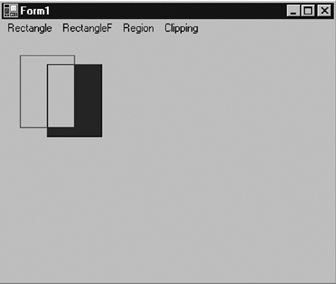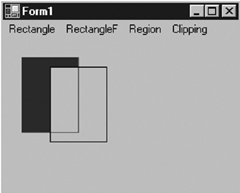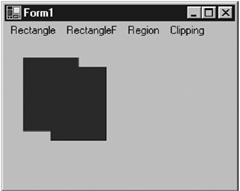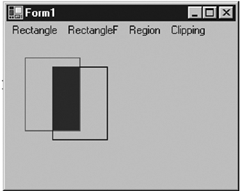The Region Class
A region describes the interior of a closed graphics shape, or form. A form has two areas: a nonclient area and a client area. The nonclient area (which does not allow for user-drawn graphics objects) includes the title barand, depending on the application, horizontal and vertical scroll bars. This area cannot be used to draw graphics objects. The client area is used to draw controls and graphics objects.
In the .NET Framework library, the Region class object represents a region. If you have ever developed a complex .NET graphics application that requires a lot of rendering, you may have used this object a lot.
6.2.1 Constructing a Region Object
The Region class provides five overloaded forms. Using these forms, you can construct a Region object from a Rectangle, RectangleF, GraphicsPath, or RegionData object, or with no parameters. The following code snippet creates Region objects in different ways using different arguments.
// Create two rectangles Rectangle rect1 = new Rectangle(20, 20, 60, 80); RectangleF rect2 = new RectangleF(100, 20, 60, 100); // Create a graphics path GraphicsPath path = new GraphicsPath(); // Add a rectangle to the graphics path path.AddRectangle(rect1); // Create a region from rect1 Region rectRgn1 = new Region(rect1); // Create a region from rect2 Region rectRgn2 = new Region(rect2); // Create a region from GraphicsPath Region pathRgn = new Region(path);
The Region class has no properties. After constructing a region, an application can use the Graphics class's FillRegion method to fill the region.
Table 6.1 describes the methods of the Region class briefly. They are discussed in detail in Section 6.2.2 through 6.2.4
6.2.2 The Complement, Exclude, and Union Methods
We saw the Region class methods in Table 6.1. Now let's use these methods in our applications.
The Complement method updates the portion of a Region object (specified by a rectangle or a region) that does not intersect the specified region. It takes an argument of type Rectangle, RectangleF, GraphicsPath, or Region and updates the region. Listing 6.7 creates two Region objects and draws rectangles with different pens. The Complement method updates only the portion of the first region that falls within the second region.
Listing 6.7 Using the Complement method of the Region class
// Create Graphics object Graphics g = this.CreateGraphics(); // Create two rectangles Rectangle rect1 = new Rectangle(20, 20, 60, 80); Rectangle rect2 = new Rectangle(50, 30, 60, 80); // Create two regions Region rgn1 = new Region(rect1); Region rgn2 = new Region(rect2); // Draw rectangles g.DrawRectangle(Pens.Green, rect1); g.DrawRectangle(Pens.Black, rect2); // Complement can take Rectangle, RectangleF, // Region, or GraphicsPath as an argument rgn1.Complement(rgn2); // rgn1.Complement(rect2); g.FillRegion(Brushes.Blue, rgn1); // Dispose of object g.Dispose();
Figure 6.5 shows the output from Listing 6.7. Our code updates a portion of rgn1 that doesn't intersect with rgn2. It is useful when you need to update only a specific part of a region. For example, suppose you're writing a shooting game application and your program updates the targets only after gunfire. In this scenario you need to update only the target region, not the entire form.
Figure 6.5. Complementing regions

|
Method |
Description |
|---|---|
|
Clone |
Creates an exact copy of a region. |
|
Complement |
Updates a region to the portion of a rectangle that does not intersect with the region. |
|
Exclude |
Updates a region to the portion of its interior that does not intersect with a rectangle. |
|
FromHrgn |
Creates a new Region object from a handle to the specified existing GDI region. |
|
GetBounds |
Returns a RectangleF structure that represents a rectangle that bounds a region. |
|
GetHrgn |
Returns a window handle for a region. |
|
GetRegionData |
Returns a RegionData object for a region. RegionData contains information describing a region. |
|
GetRegionScans |
Returns an array of RectangleF structures that approximate a region. |
|
Intersect |
Updates a region to the intersection of itself with another region. |
|
IsEmpty |
Returns true if a region is empty; otherwise returns false. |
|
IsInfinite |
Returns true if a region has an infinite interior; otherwise returns false. |
|
IsVisible |
Returns true if the specified rectangle is contained within a region. |
|
MakeEmpty |
Marks a region as empty. |
|
MakeInfinite |
Marks a region as infinite. |
|
Transform |
Applies the transformation matrix to the region. |
|
Translate |
Offsets the coordinates of a region by the specified amount. |
|
Union |
Updates a region to the union of itself and the given graphics path. |
|
Xor |
Updates a region to the union minus the intersection of itself with the given graphics path. |
The Exclude method updates the part of a region that does not interact with the specified region or rectangle. Like Complement, Exclude takes an argument of type Rectangle, RectangleF, GraphicsPath, or Region and updates the region. Listing 6.8 creates two Region objects and draws rectangles with different pens, then calls Exclude.
Listing 6.8 Using the Exclude method of the Region class
Rectangle rect1 = new Rectangle(20, 20, 60, 80); Rectangle rect2 = new Rectangle(50, 30, 60, 80); Region rgn1 = new Region(rect1); Region rgn2 = new Region(rect2); g.DrawRectangle(Pens.Green, rect1); g.DrawRectangle(Pens.Black, rect2); rgn1.Exclude(rgn2); g.FillRegion(Brushes.Blue, rgn1);
Figure 6.6 shows the output from Listing 6.8. Only the excluded part of the region is updated.
Figure 6.6. Excluding regions

From the code of Listing 6.8, replacing the line
rgn1.Exclude(rgn2);
with
rgn1.Union(rgn2);
produces Figure 6.7, which updates the union of both regions (or rectangles). Like Exclude and Complement, the Union method can take Rectangle, RectangleF, GraphicsPath, or Region as an argument.
Figure 6.7. Applying Union on regions

6.2.3 The Xor and Intersect Methods
The Xor method updates the union of both regions (or rectangles) except the intersection area of the rectangle itself. Replacing Exclude with Xor, as shown in Listing 6.9, generates Figure 6.8.
Figure 6.8. Using the Xor method of the Region class

Listing 6.9 Using the Xor method of the Region class
// Create Graphics object Graphics g = this.CreateGraphics(); g.Clear(this.BackColor); // Create rectangles Rectangle rect1 = new Rectangle(20, 20, 60, 80); Rectangle rect2 = new Rectangle(50, 30, 60, 80); // Create regions Region rgn1 = new Region(rect1); Region rgn2 = new Region(rect2); // Draw rectangles g.DrawRectangle(Pens.Green, rect1); g.DrawRectangle(Pens.Black, rect2); // Xor two regions rgn1.Xor(rgn2); // Fill the region after Xoring g.FillRegion(Brushes.Blue, rgn1); // Dispose of object g.Dispose();
The Intersect method is the reverse of Xor. It updates only the intersection region of two regions or rectangles. For example, if you replace line
rgn1.Xor(rgn2);
with the following code:
rgn1.Intersect(rgn2);
the new output will look like Figure 6.9.
Figure 6.9. Using the Intersect method of the Region class

6.2.4 GetBounds and Other Methods
The IsEmpty method takes a Graphics object as an argument and returns true if a region is empty. Otherwise it returns false. IsInfinite returns true if a region is infinite (otherwise it returns false), and it takes a Graphics object as the only argument.
The MakeEmpty and MakeInfinite methods make a region empty or infinite, respectively. An infinite region completely covers the area of a control.
The GetBounds method returns the bounds of a region. This method also takes a Graphics object as an argument.
The code in Listing 6.10 uses these methods. It makes rgn2 infinite and fills it with a red pen, which fills the entire form with red.
Listing 6.10 Using GetBounds and other methods of the Region class
// Create a Graphics object Graphics g = this.CreateGraphics(); g.Clear(this.BackColor); // Create rectangles and regions Rectangle rect1 = new Rectangle(20, 20, 60, 80); Rectangle rect2 = new Rectangle(50, 30, 60, 80); Region rgn1 = new Region(rect1); Region rgn2 = new Region(rect2); // If region is not empty, empty it if (! rgn1.IsEmpty(g)) rgn1.MakeEmpty(); // If region is not infinite, make it infinite if (! rgn2.IsInfinite(g)) rgn2.MakeInfinite(); // Get bounds of the infinite region RectangleF rect = rgn2.GetBounds(g); // Display MessageBox.Show(rect.ToString()); // Fill the region g.FillRegion(Brushes.Red, rgn2); // Dispose of object g.Dispose();
An infinite region's starting coordinates are negative numbers, and its height and width are large positive numbers, as Figure 6.10 shows. Using FillRegion on an infinite region fills the entire form.
Figure 6.10. Bounds of an infinite region

GDI+: The Next-Generation Graphics Interface
- GDI+: The Next-Generation Graphics Interface
- Understanding GDI+
- Exploring GDI+ Functionality
- GDI+ from a GDI Perspective
- GDI+ Namespaces and Classes in .NET
- Summary
Your First GDI+ Application
- Your First GDI+ Application
- Drawing Surfaces
- The Coordinate System
- Tutorial: Your First GDI+ Application
- Some Basic GDI+ Objects
The Graphics Class
- The Graphics Class
- Graphics Class Properties
- Graphics Class Methods
- The GDI+Painter Application
- Drawing a Pie Chart
Working with Brushes and Pens
- Working with Brushes and Pens
- Understanding and Using Brushes
- Using Pens in GDI+
- Transformation with Pens
- Transformation with Brushes
- System Pens and System Brushes
- A Real-World Example: Adding Colors, Pens, and Brushes to the GDI+Painter Application
Colors, Fonts, and Text
- Colors, Fonts, and Text
- Accessing the Graphics Object
- Working with Colors
- Working with Fonts
- Working with Text and Strings
- Rendering Text with Quality and Performance
- Advanced Typography
- A Simple Text Editor
- Transforming Text
Rectangles and Regions
- Rectangles and Regions
- The Rectangle Structure
- The Region Class
- Regions and Clipping
- Clipping Regions Example
- Regions, Nonrectangular Forms, and Controls
Working with Images
- Working with Images
- Raster and Vector Images
- Working with Images
- Manipulating Images
- Playing Animations in GDI+
- Working with Bitmaps
- Working with Icons
- Skewing Images
- Drawing Transparent Graphics Objects
- Viewing Multiple Images
- Using a Picture Box to View Images
- Saving Images with Different Sizes
Advanced Imaging
- Advanced Imaging
- Rendering Partial Bitmaps
- Working with Metafiles
- Color Mapping Using Color Objects
- Image Attributes and the ImageAttributes Class
- Encoder Parameters and Image Formats
Advanced 2D Graphics
- Advanced 2D Graphics
- Line Caps and Line Styles
- Understanding and Using Graphics Paths
- Graphics Containers
- Reading Metadata of Images
- Blending Explained
- Alpha Blending
- Miscellaneous Advanced 2D Topics
Transformation
- Transformation
- Coordinate Systems
- Transformation Types
- The Matrix Class and Transformation
- The Graphics Class and Transformation
- Global, Local, and Composite Transformations
- Image Transformation
- Color Transformation and the Color Matrix
- Matrix Operations in Image Processing
- Text Transformation
- The Significance of Transformation Order
Printing
- Printing
- A Brief History of Printing with Microsoft Windows
- Overview of the Printing Process
- Your First Printing Application
- Printer Settings
- The PrintDocument and Print Events
- Printing Text
- Printing Graphics
- Print Dialogs
- Customizing Page Settings
- Printing Multiple Pages
- Marginal Printing: A Caution
- Getting into the Details: Custom Controlling and the Print Controller
Developing GDI+ Web Applications
- Developing GDI+ Web Applications
- Creating Your First ASP.NET Web Application
- Your First Graphics Web Application
- Drawing Simple Graphics
- Drawing Images on the Web
- Drawing a Line Chart
- Drawing a Pie Chart
GDI+ Best Practices and Performance Techniques
- GDI+ Best Practices and Performance Techniques
- Understanding the Rendering Process
- Double Buffering and Flicker-Free Drawing
- Understanding the SetStyle Method
- The Quality and Performance of Drawing
GDI Interoperability
Miscellaneous GDI+ Examples
- Miscellaneous GDI+ Examples
- Designing Interactive GUI Applications
- Drawing Shaped Forms and Windows Controls
- Adding Copyright Information to a Drawn Image
- Reading and Writing Images to and from a Stream or Database
- Creating Owner-Drawn List Controls
Appendix A. Exception Handling in .NET
